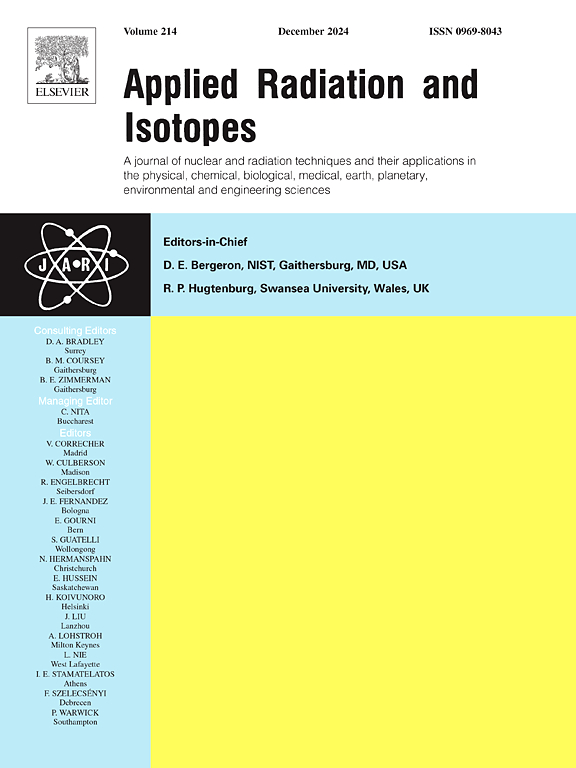用伽马射线照射大豆种子可提高遗传变异性。
IF 1.6
3区 工程技术
Q3 CHEMISTRY, INORGANIC & NUCLEAR
引用次数: 0
摘要
使用伽马射线可以通过出现新的农艺基因来提高遗传变异性。本研究的目的是对 VX04-5692 大豆品系的干种子进行不同剂量的伽马射线辐照评估,旨在提高遗传变异性,从而识别可能的突变植株。辐照剂量分别为 0、50、150 和 250 Gy,辐照源为 60Co。新辐照的种子被播种到田间,形成 M1 周期。经过挑选的植物进入 M2 周期。播种后的第 21 天开始计算秧苗的数量。每行确定 10 株,并对其各种农艺特性和化学成分进行评估。对数据进行方差分析。采用 F 检验,结果以方框图和双方框图(典型变量)表示。伽马辐射剂量对盛花期和成熟期的株高、节数、单粒荚果和每粒荚果种子都有影响。伽马辐射的使用增加了大豆的变异性,从而提高了识别新突变体的概率,并增加了化学成分,这对旨在提高农艺性状、增加油脂和蛋白质含量的育种计划非常有用。对大豆干种子进行 50 至 150 Gy 的伽马射线辐射,可在产生变异性方面获得更令人满意的结果。本文章由计算机程序翻译,如有差异,请以英文原文为准。
Genetic variability increase by gamma irradiation of soybean seeds
The increase of genetic variability by the appearance of new genes of agronomic interest may be favored by the use of gamma radiation. The objective of this study was to evaluate different doses of gamma irradiation on dry seeds of VX04-5692 soybean line, aiming to increase the genetic variability and, with this, the identification of possible mutant plants. The doses of 0, 50, 150 and 250 Gy of gamma radiation were applied from a60Co source. The newly irradiated seeds were sown in the field, giving rise to the M1 cycle. Selected plants originated the M2 cycle. The number of seedlings was counted on the 21st day after sowing. Ten plants of each row were identified and evaluated for the various agronomic characteristics and for chemical composition. The data were submitted to analysis of variance. The F test was applied and the results were presented by boxplots and biplot (canonical variables). There was effect of gamma radiation doses at plant height at full bloom and maturity, number of nodes, pods with one seed and seeds per pod. The use of gamma radiation increases the variability in soybean, with consequent increase in the probabilities of identification of new mutants and gains in the chemical composition, useful for breeding programs that aim at better agronomic performance and gains in oil and protein contents. More satisfactory results in the generation of variability are obtained by the application of gamma radiation on soybean dry seeds between 50 and 150 Gy.
求助全文
通过发布文献求助,成功后即可免费获取论文全文。
去求助
来源期刊

Applied Radiation and Isotopes
工程技术-核科学技术
CiteScore
3.00
自引率
12.50%
发文量
406
审稿时长
13.5 months
期刊介绍:
Applied Radiation and Isotopes provides a high quality medium for the publication of substantial, original and scientific and technological papers on the development and peaceful application of nuclear, radiation and radionuclide techniques in chemistry, physics, biochemistry, biology, medicine, security, engineering and in the earth, planetary and environmental sciences, all including dosimetry. Nuclear techniques are defined in the broadest sense and both experimental and theoretical papers are welcome. They include the development and use of α- and β-particles, X-rays and γ-rays, neutrons and other nuclear particles and radiations from all sources, including radionuclides, synchrotron sources, cyclotrons and reactors and from the natural environment.
The journal aims to publish papers with significance to an international audience, containing substantial novelty and scientific impact. The Editors reserve the rights to reject, with or without external review, papers that do not meet these criteria.
Papers dealing with radiation processing, i.e., where radiation is used to bring about a biological, chemical or physical change in a material, should be directed to our sister journal Radiation Physics and Chemistry.
 求助内容:
求助内容: 应助结果提醒方式:
应助结果提醒方式:


